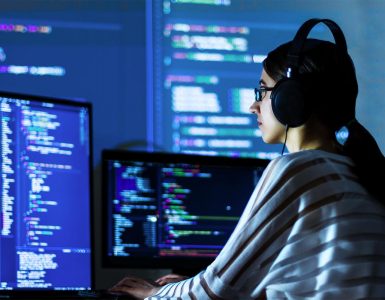Introduction
Welcome to the realm of programming languages! In this journey, we’ll explore two modern and innovative languages that have taken the tech community by storm – Golang and Rust.
These dynamic powerhouses have been making waves with their unique features, impressive performance, and the promise of solving age-old programming challenges.
Whether you’re a seasoned developer seeking a new language to master or an aspiring programmer eager to wield the tools of the trade, this is the ultimate showdown that will help you improve your knowledge base.
What is Golang?
Golang, also known as Go, is an open-source programming language developed by Google in 2007.
- It was created by a team of engineers, including Rob Pike, Ken Thompson, and Robert Griesemer.
- The goal was to address the challenges of developing scalable and efficient software for modern systems.
- Go is designed to be simple, efficient, and highly concurrent. It incorporates features from various programming languages while maintaining a straightforward syntax and a small core language specification.
- Go’s design emphasizes readability, maintainability, and productivity, making it an excellent choice for building large-scale, high-performance applications.
Key features of Golang?
Go has gained popularity among developers for various use cases, including web development, system programming, network programming, cloud computing, and distributed systems.
Some key features of Golang are included in the following illustration:

Applications of Golang
Golang (Go) has found applications in various domains due to its unique combination of features and performance. Some of the common applications of Golang include:
- Web Development
Go has a strong web development ecosystem. Its net/http package provides a robust foundation for building web servers and APIs. Frameworks like Gin, Echo, and Revel have gained popularity for developing scalable and high-performance web applications. Go’s simplicity and concurrency features make it suitable for handling concurrent requests efficiently.
- System Programming
Go’s low-level capabilities make it well-suited for system programming tasks. It enables developers to build tools, utilities, and applications that interact directly with the operating system or hardware. Docker, a popular containerization platform, is primarily implemented in Go, showcasing its ability to handle system-level tasks effectively.
- Network Programming
Go’s built-in support for concurrency, and its networking packages make it ideal for network programming tasks. It enables developers to create networking applications, including servers, clients, and proxies, that can handle a large number of concurrent connections efficiently.
- Distributed Systems
Go’s concurrency features and lightweight goroutines make it well-suited for building distributed systems. Tools like Kubernetes, etc., and Consul are implemented in Go, showcasing its capabilities for managing distributed systems and coordinating clusters of machines.
- Cloud Computing
Go’s efficiency and support for concurrency make it a natural fit for cloud computing environments. It is used in cloud infrastructure tools and platforms, such as Google Cloud Platform, Heroku, and Cloud Foundry, to build scalable and reliable cloud services.
What is Rust?
Rust is a modern, open-source programming language that was created by Mozilla and first appeared in 2010.
- It was designed to address the challenges of developing reliable, safe, and concurrent systems software.
- Rust combines low-level control over system resources with high-level abstractions, aiming to provide memory safety, concurrency, and performance.
Features of Rust
Rust’s strong emphasis on memory safety, combined with its concurrency support and performance characteristics, make it a compelling choice for developers seeking a modern and reliable programming language for systems-level and performance-critical applications.
The following illustration explains the key features of Rust:

Applications of Rust
Rust is a versatile programming language that finds applications in various domains. Some notable applications of Rust include:
- Systems Programming: Rust is well-suited for systems programming tasks, where low-level control over system resources, memory safety, and performance are essential. It is used to develop operating systems, device drivers, embedded systems, and other system-level software.
- Web Development: Rust is gaining popularity in web development due to its ability to handle concurrency and its performance characteristics. Web frameworks like Rocket and Actix-web provide a foundation for building fast and secure web applications.
- Networking and Servers: Rust’s strong concurrency support and low-level control make it suitable for developing networking tools, servers, proxies, and load balancers. Projects like Tokio and Hyper focus on building efficient network applications in Rust.
- Blockchain and Cryptocurrency: Rust is being adopted in the blockchain and cryptocurrency space due to its focus on security and performance. Projects like Parity Ethereum and Solana leverage Rust for building blockchain platforms and decentralized applications.
- Game Development: Rust’s control over system resources, performance, and ability to integrate with other programming languages make it suitable for game development. The Amethyst game engine and the Bevy game engine are examples of Rust-based frameworks for game development.
Guide To Golang vs Rust
Following are the differences between Golang and Rust:
Memory Safety and Concurrency
Go provides built-in concurrency support with goroutines and channels. It emphasizes simplicity and ease of use. Although Go has garbage collection, it doesn’t provide the same level of memory safety guarantees as Rust.
Rust’s unique feature is its focus on memory safety without sacrificing performance. It enforces strict compile-time checks and borrows its ownership and borrowing system to prevent memory-related bugs. This makes Rust highly suitable for systems programming and critical software where memory safety is crucial.
Performance and Efficiency
- Go is known for its excellent performance and efficiency. It compiles machine code and offers built-in support for concurrent programming, making it efficient for handling concurrent tasks. Go’s garbage collector helps manage memory automatically, but it can introduce occasional pauses.
- Rust is designed to provide high performance and efficiency. It offers fine-grained control over system resources, enabling developers to write code with minimal overhead. Rust’s ownership system and lack of garbage collection allow for predictable and deterministic memory management.
Ecosystem and Community
- Go has a mature and growing ecosystem with versatile availability of libraries and tools. It has gained popularity in web development, network programming, and concurrent systems due to its simplicity and performance. The Go community is known for its focus on developer productivity and code readability.
- Rust’s ecosystem is rapidly expanding but still growing. It has strong support for systems programming, embedded development, and cryptographic libraries. Rust has a vibrant community focused on safety, reliability, and performance. However, the learning curve for Rust can be steeper due to its emphasis on memory safety and complex ownership system.
Use Cases and Domains
- Well-suited for web development, network programming, and concurrent systems. It shines in building scalable servers, APIs, and tools that handle high levels of concurrency. Go’s simplicity and performance make it a popular choice for cloud computing, microservices, and DevOps tooling.
- Ideal for systems programming, where memory safety and performance are critical, such as building operating systems, device drivers, and embedded systems. It is also gaining traction in domains like blockchain, networking infrastructure, and security-focused applications.
Syntax and Learning Curve
- Go has a simple and straightforward syntax that is easy to read and write. It aims for minimalism and readability, making it relatively easy to grasp for developers with experience in other C-like languages.
- Rust has a more complex syntax, primarily due to its ownership and borrowing system. It requires developers to understand concepts like lifetimes and ownership, which can have a learning curve, especially for those who are new to systems programming or memory management.
Frequently Asked Questions
Q: What are the major differences between Golang and Rust?
A: Golang (Go) and Rust are both modern programming languages, but they have distinct characteristics and use cases. Some major differences include:
Memory Safety: Rust has a strong focus on memory safety and uses its ownership and borrowing system to prevent common memory-related bugs at compile-time. Go, while providing memory safety to some extent, does not offer the same level of guarantees as Rust.
Concurrency Models: Go has built-in support for concurrency with goroutines and channels, making it easy to write concurrent programs. Rust’s concurrency is based on the async/await syntax and the Tokio runtime, which provides more control over asynchronous programming.
Syntax and Learning Curve: Go has a simple and straightforward syntax, making it easier to learn for developers familiar with C-like languages. Rust’s syntax is more complex, particularly due to its ownership and borrowing system, which can require a steeper learning curve.
Q: What are the similarities between Golang and Rust?
A: Despite their differences, Golang and Rust share some similarities:
Performance: Both languages are designed for high performance. Go compiles efficient machine code, and Rust allows fine-grained control over system resources, enabling developers to write code with minimal overhead.
Concurrency Support: Both Go and Rust provide robust support for writing concurrent programs. Go’s goroutines and channels, as well as Rust’s async/await syntax and Tokio runtime, enable developers to handle concurrent tasks efficiently.
Modern and Growing Ecosystems: Both languages have active and growing communities, contributing to a diverse ecosystem of libraries, frameworks, and tools.
Q: What is better, Golang or Rust?
A: The choice between Golang and Rust depends on the unique requirements of your development project and the preferences of your development team.
Golang is better if: You prioritize simplicity, ease of use, and developer productivity. Golang’s focus on concurrency, efficiency, and readability makes it an amazing choice for building web applications, microservices, and DevOps tooling.
Rust is better if: You need memory safety guarantees, fine-grained control over system resources, and performance-critical systems. Rust excels in systems programming, embedded development, cryptographic libraries, and security-focused applications.
Wrapping Up
Ultimately, both languages have their strengths and are gaining popularity in different domains.
Evaluating your project’s needs and considering factors such as memory safety, performance, and concurrency requirements will help you make an informed decision on whether Golang or Rust is the better fit for your specific use case.






Add comment